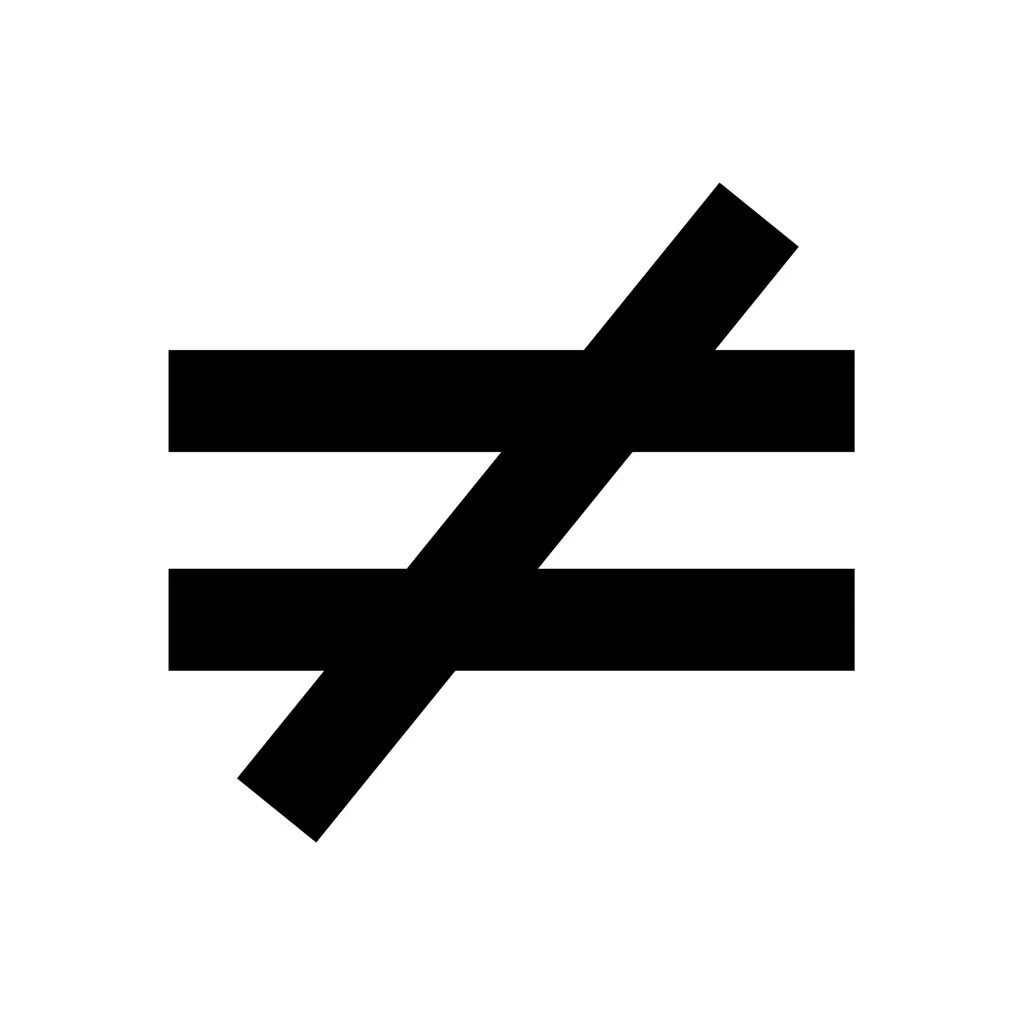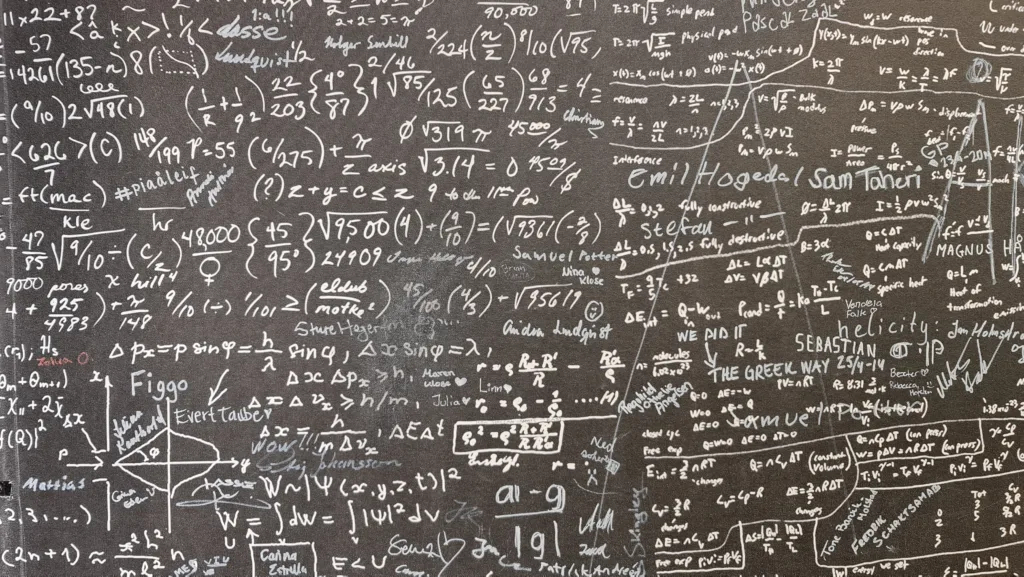The “does not equal” symbol, or ≠, is an important mathematical notation that represents inequality between two quantities. It is often used in equations, formulas, and mathematical expressions to indicate that two values are not equal to each other.
The not equal symbol consists of two parallel horizontal lines that are intersected by a diagonal slash. This symbol is used to signify that two values are not the same or equal in quantity, size, or value. For example, if we compare the values of 5 and 7, we can say that 5 ≠ 7, which means that 5 is not equal to 7.
The not equal symbol is widely used in mathematical equations, computer programming languages, and scientific research. It is an essential tool for expressing concepts of inequality and for comparing values in various fields of study. In mathematics, the not equal symbol is used in simple arithmetic operations such as addition, subtraction, multiplication, and division.
The not equal sign is also used in more complex operations such as calculus, geometry, and statistics. For example, in calculus, it is used to denote the inequality between two functions or limits. In geometry, it is used to represent the difference in size or length between two geometric shapes. In statistics, it is used to compare the values of two variables or data sets.
In computer programming languages, the not equal symbol is used to compare values and expressions. For instance, it is used in conditional statements such as “if not equal to” or “while not equal to” to control the flow of a program. Programmers also use the not equal symbol to compare variables and data types in programming languages such as Java, Python, and C++.
The not equal symbol, or ≠, is an important mathematical notation that represents inequality between two quantities. It is widely used in various fields of study such as mathematics, computer science, and science. It is a vital tool for expressing concepts of inequality and for comparing values in diffrent contexts. Understanding and using the not equal symbol is essential for anyone studying or working in these fields.
What Does the Symbol ‘Greater Than or Equal To’ Mean?
The symbol ≥ represents the mathematical concept of “greater than or equal to”. This symbol indicates that the value on the left side of the symbol is either greater than or equal to the value on the rigt side of the symbol. It is often used in mathematical equations, comparisons, and inequalities to indicate a relationship between two values. For example, if we say that x is greater than or equal to y, we write it as x ≥ y, which means that x is either greater than y or it is equal to y. The symbol ≥ is an important mathematical symbol that is used extensively in various fields of mathematics, science, and engineering.

The Symbol for Does Not Equal
The symbol for “does not equal” is ≠. This symbol is used in mathematics and logic to represent inequality beteen two values or expressions. It is also used in programming and computer science to denote that two values are not equal to each other. The symbol consists of two horizontal lines with a diagonal slash through them, indicating that the values on either side of the symbol are not equal. Although this symbol may not be present on some standard keyboards, it can usually be accessed through the use of keyboard shortcuts or by using the character map tool in your operating system.
What Does Not Equal Mean?
The term “not equal” is used to convey the idea of inequality between two quantities, objects or values. It is a mathematical symbol and represents a comparison between two objects, indicaing that they are not the same. The symbol used to represent “not equal” is a pair of parallel horizontal lines that are intersected by a diagonal line, forming a symbol that looks like “≠”. This symbol is used primarily in mathematical equations or programming languages. Whenever this symbol is used, it means that the two objects being compared are not equal, and there is a difference between them. In summary, “not equal” is a mathematical term that implies the inequality or the difference between two objects or values.
Using the Not Equal Sign in Writing
To write “do not equal” in mathematical or programming contexts, you can use the “not equal to” symbol whch looks like a slashed equal sign. This symbol can be inserted using different methods depending on the context.
In Microsoft Word or other word processing software, you can insert the symbol by going to the “Insert” tab, selecting “Symbol,” and choosing the “not equal to” symbol from the list. Alternatively, you can use the keyboard shortcut “Alt + 8800” on the numeric keypad to insert the symbol.
In programming languages such as C++, Java, or Python, the “not equal to” symbol is represented by the exclamation mark followed by the equal sign, like this: “!=”. This operator can be used to compare two values and check if they are not equal.
Overall, using the “not equal to” symbol or operator is a clear and concise way to express that two things are not equivalent or identical.
The Meaning of := in Mathematics
In mathematics, the symbol := is used to indicate that a term or expression on the left-hand side of the symbol is defined or assigned a specific value by the expression on the right-hand side. This symbol is called the “equal by definition” sign and it means “is equal by definition to”. It is a common notation used in mathematical logic and computer programming, where it is used to define or assign values to variables, constants, functions, and other mathematical objects. The := symbol is an alternative form of the symbol “=Def”, whih was introduced in the 1894 book Logica Matematica by the logician. This notation is an important tool in mathematical reasoning and helps to establish precise definitions and relationships between mathematical objects.

What Does DOS Stand For?
DOS is an abbreviation for “Disk Operating System”. It refers to a type of operating system that is designed to run from a disk drive, which allows users to perform various tasks and operations on their computer systems. Although DOS can refer to a range of disk operating systems, the most well-known and widely used DOS is MS-DOS, which stands for Microsoft Disk Operating System. MS-DOS was developed by Microsoft Corporation and was the standard operating system for IBM-compatible personal computers during the 1980s and 1990s.
The Difference Between ‘Is’ and ‘Is Not’
No, the “!=” (not-equal-to) and “==” (equal-to) operators are not the same. The “==” operator returns true if both operands have the same value, while the “!=” operator returns true if the operands don’t have the same value. In other words, the “==” operator checks for equality, whereas the “!=” operator checks for inequality. So, if you want to test if two values are equal, you would use the “==” operator, and if you want to test if they are not equal, you would use the “!=” operator.
The Difference Between ‘Is’ and ‘Not’
In Python, the != operator and the not keyword are not exactly the same, although they are related. The != operator is used to check whether two values or expressions are not equal to each other. It returns a boolean value of True if the operands are not equal, and False if they are equal.
On the other hand, the not keyword is a logical operator that negates a boolean expression. It returns True if the expression is False, and False if the expression is True. This means that the not keyword can be used to invert the result of a boolean expression, but it canot be used to check whether two values or expressions are equal to each other.
So while both the != operator and the not keyword are used to test for inequality or non-equality, they operate on different types of operands and serve different purposes.
What Does ‘Not Equal To’ Mean in a Formula?
The “!=” symbol, also known as the “not equal to” comparison operator, is used in formulas in Excel to compare two values and check if they are not equal to each other. This symbol is represented as “” in Excel. When we use the “!=” symbol in a formula, it returns a Boolean vlue of either True or False. If the two values being compared are not equal, then the formula returns True, and if they are equal, the formula returns False. This comparison operator is useful in various scenarios, such as checking for duplicate values, identifying differences between two sets of data or comparing values in conditional formatting. In summary, the “!=” symbol is a powerful tool for comparisons in Excel that helps users to quickly identify disparities in their data.

Examples of Not Equal
The example of not equal refers to any two values that are not equal to each other. For instance, if we take the values 7 and 5, we can see that they are not equal to each other since 7 is greater than 5. In mathematical terms, we represent this as 7 ≠ 5, where the symbol ‘≠’ stands for ‘not equal’. This symbol is used to indicate that the values on either side of it are not the same. Therefore, any two values that are not equal can be represented using the ‘not equal’ symbol.
The Meaning of Equality
The word for equal means not different or not differing from one aother in terms of value, quantity, quality, or any other characteristic. There are several words that can be used to convey the meaning of equal, such as same, selfsame, very, identical, equivalent, and equal itself. These words can be used interchangeably to refer to things or concepts that are identical, indistinguishable, or have the same value or importance. For instance, one can say that two numbers are equal, two objects are identical, two concepts are equivalent, or two qualities are of the same value. Overall, the word equal is commonly used to describe a state of balance, fairness, or justice, where all parties or elements are treated equally or have the same opportunities and rights.
Writing an Equal Sign
To write an equal sign, you can use the “=” symbol on your keyboard. On most keyboards, the equal sign can be found on the same key as the plus sign, located in the top row of keys beteen the backspace and the opening square bracket. To type the equal sign, simply press the shift key and the “=” key at the same time. The equal sign is commonly used in mathematics and programming to indicate that two values or expressions are equivalent. It is a fundamental symbol that is used across various fields and disciplines to represent the concept of equality.
Testing for Not Equal To Null
In SQL, to write not equal to null, you need to use the “is not null” operator instead of the “!=” or “” operators. This is becaue null is not a value, but rather represents the absence of a value. Therefore, it cannot be compared to any other value using a standard comparison operator.
For example, to select all records from a table where the column “name” is not null, you can use the following SQL query:
SELECT * FROM table_name WHERE name IS NOT NULL;
This will retrieve all records where the “name” column has a value that is not null. On the other hand, if you were to use the “!=” or “” operator, the result would be incorrect, as it would not account for null values.
Conclusion
In conclusion, the “does not equal” symbol, or ≠, is an essential mathematical symbol used to show the inequality between two quantities. It is represented by two parallel horizontal lines cut by an inclined vertical line. Although it may not be readily available on standard keyboards, you can easily insert it in a Word document using the Alt key in combination with numeric keypad numbers. The “does not equal” symbol is a crucial tool in mathematical equations and comparisons, helping to indicate when two quantities are not equal. By using this symbol, we can express a range of mathematical concepts and ensure accurate calculations. Overall, the “does not equal” symbol plays a vital role in mathematics and shold always be considered when dealing with numerical comparisons.
